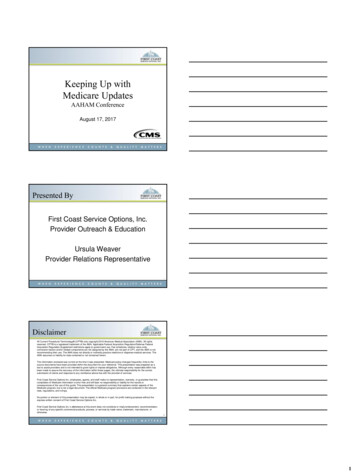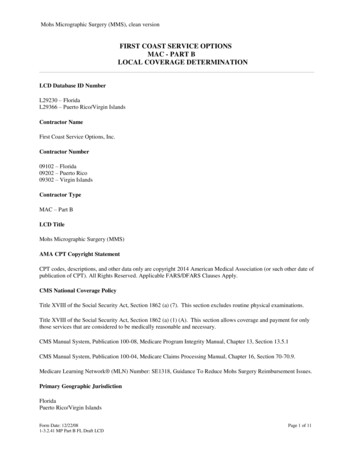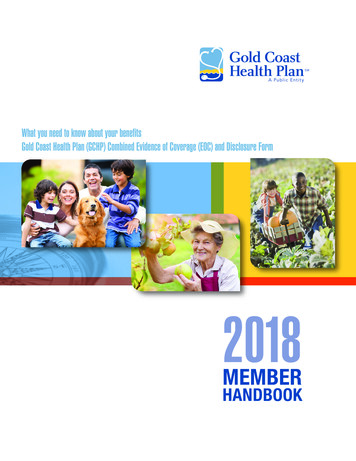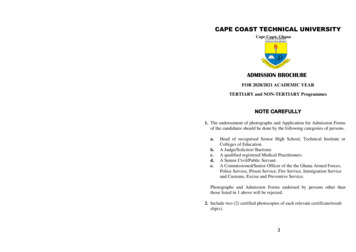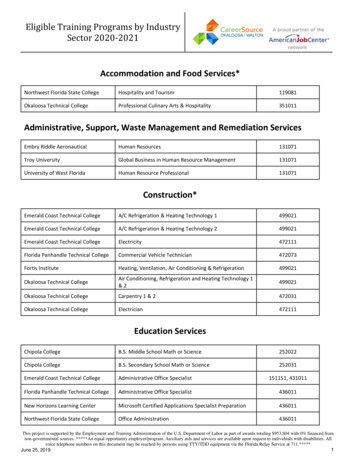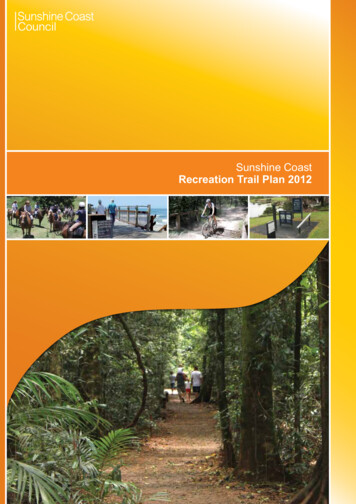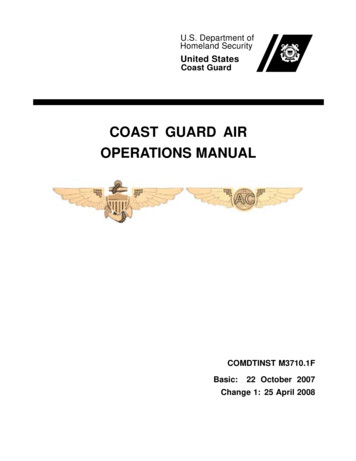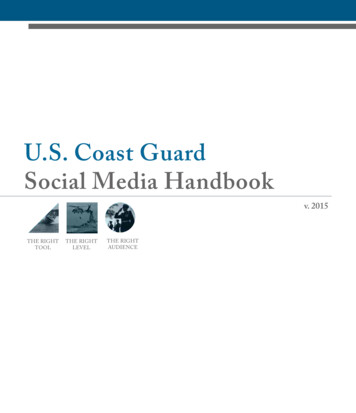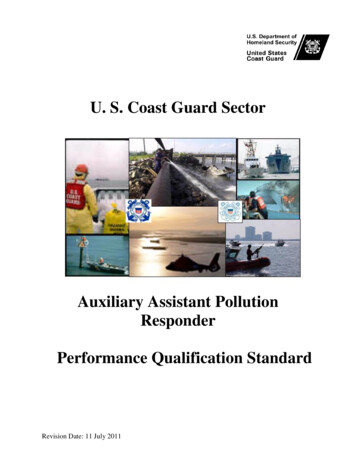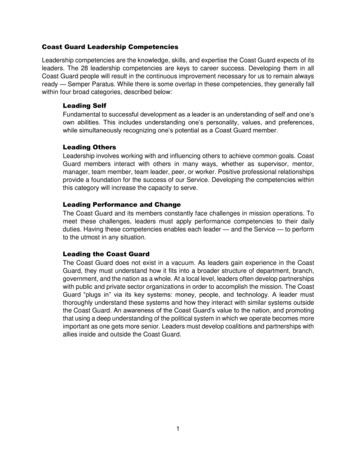
Transcription
First Coast Service Options (FCSO)Medicare Policy PrimerMedicare Jurisdiction (JN)Florida, Puerto Rico and U.S. Virgin IslandsApplication of Skin Substitute Grafts for the treatment of DFU and VLUof Lower Extremities—#L36377Indications Presence of neuropathic diabetic foot ulcer(s) having failed to respond to documentedconservative wound-care measures of greater than four weeks. Presence of a chronic, non-infected venous stasis ulcer with failure to respond todocumented conservative wound-care measures (outlined below) for greater than4-6 weeks with documented compliance. For purposes of this LCD, conservative wound care measures include, but are notlimited to:1. Comprehensive patient assessment (history, exam, ABI (Ankle-Brachial Index)& diagnostic test as indicated) and implemented treatment plan.2. For patient with DFU: Assessment of type I vs. II Diabetes Mellitus andmanagement history with attention to certain comorbidities (vascular disease,neuropathy, osteomyelitis); review of the current blood sugars/ HgbA1c, diet andnutritional status, activity level, physical exam that includes assessment of skinand wound, ABI (Ankle-Brachial Index), check of off-loading prosthetics or shoesfor signs of abnormal wear.3. For patient with VLU: Assessment of history (prior ulcers, thrombosis risks),physical exam (edema, skin changes), ABI (Ankle-Brachial Index), and duplexscan to confirm CEAP classification (Clinical-Etiology-Anatomy-Pathophysiology(*CEAP) classification categorizes chronic venous disorders to facilitatecommunication between physicians, to serve as a basis for standardized reportingduring scientific analysis of management alternatives, and to identify segments ofvenous incompetence amenable to vein ablation therapies.4. Implemented treatment plan as indicated.
Applied to ulcers that have failed to respond to documented conservative wound-caremeasures. “Failed response” is defined as an ulcer that has increased in size or depth,or no change in baseline size or depth or no sign of improvement or indication thatimprovement is likely (such as granulation, epithelialization or progress towards closing).Documentation of response requires measurements of the initial ulcer, measurementsat the completion of at least four weeks DFU (4-6 weeks for VLU) of conservativewound-care measures and measurements immediately prior to placement of the skinsubstitute graft. For VLUs, completion of conservative wound-care measures mustinclude 4-6 weeks and on-going compression therapy.Limitations One specific skin substitute graft product will be allowed for the episode of skinreplacement surgery wound care (defined as 12 weeks from the first application of askin substitute graft) assuming its use is not in conflict with FDA assessments andassuming there is one related wound. (See utilization guidelines.) Switching products in a 12-week episode of skin replacement surgery wound care orapplication of a product beyond 12-weeks is not expected. (See utilization guidelines.) Repeat applications of skin substitute grafts are not considered medically reasonableand necessary when a previous application was unsuccessful. Unsuccessful treatmentis defined as increase in size or depth of an ulcer or no change in baseline size ordepth and no sign of improvement or indication that improvement is likely (such asgranulation, epithelialization or progress towards closing). Application of skin substitute grafts are contraindicated and noncovered in patientswith inadequate control of underlying conditions or exacerbating factors, or othercontraindication (e.g., uncontrolled diabetes, active infection, active charcotarthropathy of the ulcer extremity, active vasculitis). Use of surgical preparation services (CPT codes 15002, 15003, 15004, and 15005) inconjunction with routine, simple and/or repeat application of skin substitute grafts is notreasonable and necessary and will be denied accordingly. Though arterial insufficiency ulcers, pressure sores, traumatic wounds, mixed ulcers,and post-surgical wounds are not directly addressed by this LCD, the comprehensivepatient assessment and treatment plan requirement would apply to any patient withlower extremity ulcers/chronic wounds. Diagnosis coding to avoid the applications ofthis policy is abuse. It is the expectation that only one specific skin substitute graft product will be used forthe episode of skin replacement surgery wound care (defined as 12 weeks from thefirst application of a skin substitute graft) assuming its use is not in conflict with FDAassessments and assuming there is one related wound. The rare clinical circumstancenecessitating switching to a different product must be clearly supported in the medicalrecord and may be subject to pre- or post-payment medical review. Repeat applicationof a skin substitute graft within the 12 week episode of skin replacement surgery woundcare may be considered upon re-assessment and must be supported in the medicalDisclaimer: This document is for informational purposes only. Use of this information does not guarantee coverage or paymentfor these services by Medicare or other payers. Physicians and other providers should use independent judgment when selectingcodes that most appropriately describe the services provided to a patient. Physicians and hospitals are solely responsible forcompliance with Medicare and other payers’ laws, rules, and requirements. For the full LCD, please refer to www.CMS.gov
record documentation for that encounter. Repeated application of a skin substitutegraft after 12 weeks could result in claim denial(s) and/or initiate a request for recordsand complex medical review addressing DFU and VLU wound care services. Medicare does not expect that every ulcer in every patient will require the maximumnumber of applications listed on the product label. The expectation is the fewestrepeat applications and amount of product to heal the wound. Utilization of more than one application of a skin substitute product in the 12 weekepisode of skin replacement surgery wound care, for all indications, may be subject topre- or post-payment medical review (record requested). Physician and allied providers demonstrating higher application utilization than peersfor similar episodes of care may be subject to pre-payment medical review (recordsrequested) or post-payment audit.Documentation Medical record documentation maintained by the treating provider mustsubstantiate the medical necessity of the services being billed. In addition,documentation that the service was performed must be included in the patient’smedical record. This information is normally found in the history and physical,office/progress notes, hospital notes, and/or procedure report. The medical record must clearly show that the criteria listed under the“Indications and Limitations of Coverage and/or Medical Necessity” sectionshave been met, as well as, the appropriate diagnosis and response to treatment.Description of the wound(s) must be documented at baseline (prior to beginningconservative wound care measures) relative to size, location, stage, duration, andpresence of infection, in addition to the type of treatment given and response. Thisinformation must be updated in the medical record throughout the episode of skinreplacement surgery wound care. Wound description must also be documentedpre- and post-treatment with the skin substitute graft being used. If obvious signsof worsening or lack of treatment response is noted, continuing treatment with theskin substitute graft would not be considered medically reasonable and necessary.The reason(s) for any continued application should be specifically addressed in themedical record, though it may not be a covered service. Documentation of smoking history and that the patient has received counseling onthe effects of smoking on surgical outcomes and treatment for smoking cessation(if applicable). Any amount of wasted skin substitute must be clearly documented in theprocedure note with the following minimum information: Date, time and location ofulcer(s) treated; Name of skin substitute and how product supplied; Approximateamount of product unit used; Approximate amount of product unit discarded; Reasonfor the wastage; Manufacturer’s serial/lot/batch or other unit identification number ofgraft material. When manufacturer does not supply unit identification, record mustdocument such.Disclaimer: This document is for informational purposes only. Use of this information does not guarantee coverage or paymentfor these services by Medicare or other payers. Physicians and other providers should use independent judgment when selectingcodes that most appropriately describe the services provided to a patient. Physicians and hospitals are solely responsible forcompliance with Medicare and other payers’ laws, rules, and requirements. For the full LCD, please refer to www.CMS.gov
CodingHCPCS Codes: Q4101: Apligraf, per square centimeter Q4106: Dermagraft, per square centimeter Q4172: PuraPly, PuraPly Antimicrobial per square centimeter Q4159: Affinity, per square centimeter Q4160: NuShield, per square centimeterJW Modifier:Effective January 1, 2017 in Physician Office Setting, Place of service 11: Claimsfor discarded drug or biological amount not administered to any patient, shall besubmitted using the JW modifier. This modifier, billed on a separate line, will providepayment for the amount of discarded drug or biological. Providers must document thediscarded drugs or biologicals in patient's medical record.CPT Codes:Application Codes for Leg, Arm or Trunk: 15271: Application of skin substitute graft to trunk, arms, legs, total wound surfacearea up to 100 sq cm; first 25 sq cm or less wound surface area 15272: Application of skin substitute graft to trunk, arms, legs, total wound surfacearea up to 100 sq cm; each additional 25 sq cm wound surface area, or part thereof(List separately in addition to code for primary procedure) 15273: Application of skin substitute graft to trunk, arms, legs, total wound surfacearea greater than or equal to 100 sq cm; first 100 sq cm wound surface area 15274: Application of skin substitute graft to trunk, arms, legs, total wound surfacearea greater than or equal to 100 sq cm; each additional 100 sq cm wound surfacearea, or part thereof (List separately in addition to code for primary procedure)Application Codes for Foot, face, scalp, etc.: 15275: Application of skin substitute graft to face, scalp, eyelids, mouth, neck, ears,orbits, genitalia, hands, feet, and/or multiple digits, total wound surface area up to 100sq cm; first 25 sq cm or less wound surface area 15276: Application of skin substitute graft to face, scalp, eyelids, mouth, neck, ears,orbits, genitalia, hands, feet, and/or multiple digits, total wound surface area up to 100sq cm; each additional 25 sq cm wound surface area, or part thereof (List separately inaddition to code for primary procedure) 15277: Application of skin substitute graft to face, scalp, eyelids, mouth, neck, ears,orbits, genitalia, hands, feet, and/or multiple digits, total wound surface area greaterthan or equal to 100 sq cm; first 100 sq cm wound surface areaDisclaimer: This document is for informational purposes only. Use of this information does not guarantee coverage or paymentfor these services by Medicare or other payers. Physicians and other providers should use independent judgment when selectingcodes that most appropriately describe the services provided to a patient. Physicians and hospitals are solely responsible forcompliance with Medicare and other payers’ laws, rules, and requirements. For the full LCD, please refer to www.CMS.gov
15278: Application of skin substitute graft to face, scalp, eyelids, mouth, neck, ears,orbits, genitalia, hands, feet, and/or multiple digits, total wound surface area greaterthan or equal to 100 sq cm; each additional 100 sq cm wound surface area, or partthereof (List separately in addition to code for primary procedure)Disclaimer: This document is for informational purposes only. Use of this information does not guarantee coverage or paymentfor these services by Medicare or other payers. Physicians and other providers should use independent judgment when selectingcodes that most appropriately describe the services provided to a patient. Physicians and hospitals are solely responsible forcompliance with Medicare and other payers’ laws, rules, and requirements. For the full LCD, please refer to www.CMS.gov
FCSO Medicare Sample Model DocumentationMedicare Jurisdiction (JN)Florida, Puerto Rico and U.S. Virgin IslandsPre-Treatment1. Duration of ulcer: weeks2. Exact location of ulcer3.Describe adequate treatment of the underlying disease process contributing to the ulcer4. Diagnosis of patient5. Implement Treatment plan as indicated:a. Debridementb. Pressure relief [repositioning schedule, etc. for DFUs/VLUs; prior and on-goingcompression therapy (e.g. static compression includes compression hosiery( 20 mm HG) and compression bandages) for VLUsc. Infection controld. Management of exudate- maintenance of a moist environment (moist salinegauze, other classic dressings, bioactive dressing, etc.). (For indications ofnegative pressure wound therapy (NPWT) see DME MAC LCD NegativePressure Wound Therapy Pumps (L5008))e. Patient is a nonsmoker, or has refrained from smoking for at least 6 weeks priorto planned skin replacement surgery, or has received counseling on the effects ofsmoking on surgical outcomes and treatment for smoking cessation.Treatment6. Document measurement of ulcer (width and length or circumference and depth)immediately prior to application of the skin substitute sq cm7. Document whether this is an initial application of skin substitute or a reapplication.8. For skin substitute reapplications, document that applications have been successful(e.g. decrease in size or depth, increase in granulation tissue).9. Document the wound dressing changes and the standard conservative measuresaccompanying the wound treatment with the skin substitute.10. Document how the wound site was prepared, and how the skin substitute wasfixated on the wound.Disclaimer: This document is for informational purposes only. Use of this information does not guarantee coverage or paymentfor these services by Medicare or other payers. Physicians and other providers should use independent judgment when selectingcodes that most appropriately describe the services provided to a patient. Physicians and hospitals are solely responsible forcompliance with Medicare and other payers’ laws, rules, and requirements. For the full LCD, please refer to www.CMS.gov
11. Document an assessment (generally in an E/M service) outlining the plan for skinreplacement surgery and the choice of skin substitute product for the 12 week periodas well as any anticipated repeat applications in the 12 week period.12. Documentation of smoking history and that the patient has received counseling onthe effects of smoking on surgical outcomes and treatment for smoking cessation (ifapplicable).13. Product Wastage Documentation Requirements: Date and time Location of ulcer Approximate amount of product unit used Approximate amount of product unit discarded Reason for the wastage Manufacture’s serial/lot/batch numberModifiersJW: Skin substitute not applied to wound, wastageDisclaimer: This document is for informational purposes only. Use of this information does not guarantee coverage or paymentfor these services by Medicare or other payers. Physicians and other providers should use independent judgment when selectingcodes that most appropriately describe the services provided to a patient. Physicians and hospitals are solely responsible forcompliance with Medicare and other payers’ laws, rules, and requirements. For the full LCD, please refer to www.CMS.gov
First Coast Service Options (FCSO) Medicare Policy Primer Medicare Jurisdiction (JN) Florida, Puerto Rico and U.S. Virgin Islands Application of Skin Substitute Grafts for the treatment of DFU and VLU of Lower Extremities—#L36377 Indications Presence of neuropathic diabetic foot ulcer(s) having failed to respond to documented
